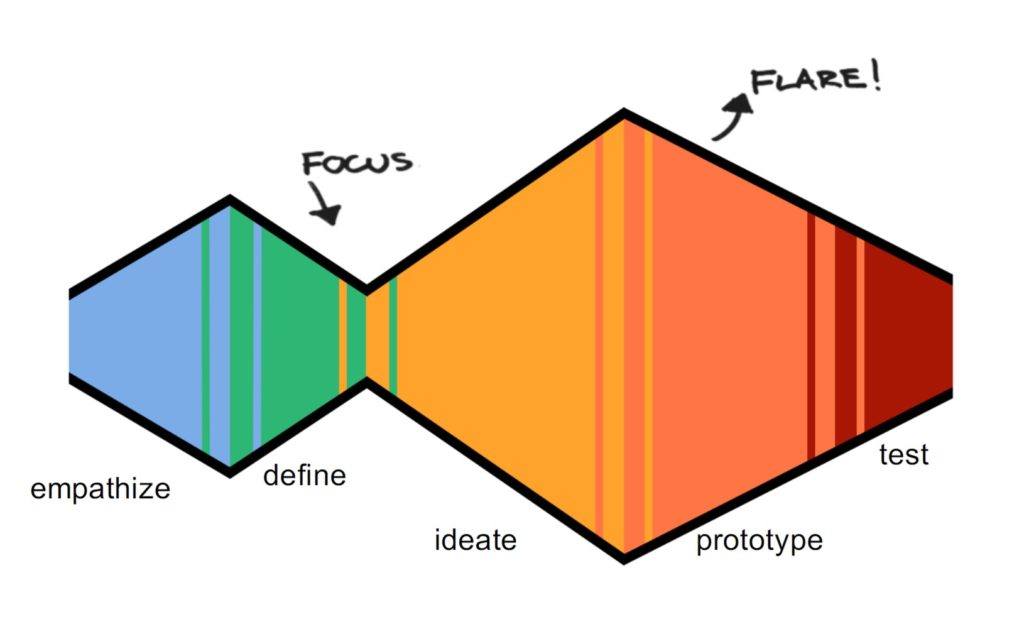Picture this: You arrive at a workshop to learn about policy innovation with design thinking. You think it will be a breeze, you settle in to listen, maybe take notes. Instead: you’re partnered up with someone you’ve never met before, and challenged to design an innovation improving their daily commute. You’re asked to be ‘creative’ and ‘curious’. You have one hour. Go!
Does the idea of designing a solution in an hour for someone you just met make you feel uncomfortable? It might if you’ve never participated in a design sprint. That’s because design sprints intentionally take us to a place just beyond our comfort zone where we’re more likely to generate new ideas and see innovations emerge.
Design thinking is an iterative, human centred and action-oriented process. It requires flexible and agile thinking, with a bias towards creativity – a state of mind we at Astrolabe continuously nurture and incorporate into our work. It’s a process that takes us through the double diamond of “flare and focus” as we better understand the challenges, and the people involved, in whatever policy area you are designing for.

Image: The d.school at Stanford University – approach to design thinking
Curiosity…about people
A fundamental aspect of design thinking is harnessing your curiosity to better understand the people most. That’s why we ask our participants to start the design challenge by really understanding their partners through interviewing, and park assumptions and solution jumping aside.
Successfully addressing a complex issue should be grounded in empathy and curiosity, ringing true to the ‘nothing about us, without us’ philosophy. When I was working on developing a strategy to tackle youth homelessness in a mid-sized Canadian city, making space for youth voice was critical. The approach we implemented in Canada embraced design thinking, using tools such as journey mapping, empathy mapping, and personas to capture people’s experiences and help build solutions together.
Test, iterate and prototype
Ever heard someone say, “I’m not creative enough”, “I can’t draw” or “that’s just not how my brain works”? We all have. Being strategic and innovative requires some creativity. Through our work we emphasize a mindset biased towards action, showing and sharing. We want people to explore, touch and play with the ideas they’ve come up with.
Innovative policy development occurs on a spectrum of continuous improvement. Being adaptive and bold requires policy professionals to continuously test and challenge ideas.

Testing gives you space to fail and iterate. Validation ensures your customers or stakeholders have their needs and wants understood and built into solutions, bringing them along on the journey.
Prototyping – even in policy development – can be a hands-on process where you bring solutions and ideas to life. Even low-fidelity mock ups and role plays allows participants to play with and test ideas – and adjust as needed to arrive at a better solution.
Components of policy innovation
The design thinking approach can help unlock practical and innovative solutions – but design thinking is only one element of policy innovation.
Achieving policy innovation happens at the nexus of design, multidisciplinary teams and engagement.
We’ll be exploring the components of policy innovation over the course of this year. Keep an eye out for future articles on policy innovation! Get in touch if you want to explore policy innovation in design thinking further.
This article was written by consultant, Belinda Jackson, who is passionate about social justice and policy development through a systems and design thinking approach.
Our CEO, Belinda Comninos, and consultant, Belinda Jackson, facilitated our Summer Masterclass for Policy Innovation with human centred design in February 2020. If you’re interested in bringing this Masterclass into your workplace get in touch and we’d be happy to talk more.
